Ah, Aloo Gobi—now there’s a dish that really warms the soul. You know, there’s something special about this combination of tender potatoes and cauliflower that just feels like home. It’s not fancy, but boy, does it pack a punch in the flavor department. With a sprinkle of earthy turmeric and a dash of aromatic garam masala, you’ve got yourself a curry that’s as comforting as an old sweater.
Now, I’m not saying you’ll become a master chef overnight, but this recipe is all about simple ingredients and straightforward steps. Perfect for a cozy weeknight dinner or when you’re looking to impress without breaking a sweat. So, roll up your sleeves and let’s dive into making this timeless classic that has been gracing tables for ages. Trust me, once you get the hang of it, you’ll be making Aloo Gobi on repeat!
Ingredients
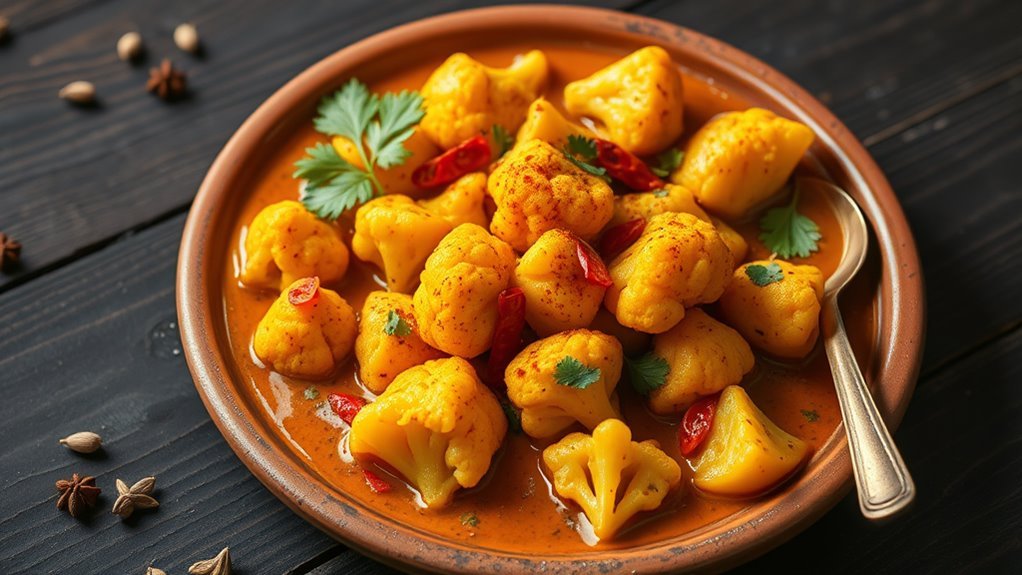
Aloo Gobi curry combines tender potatoes and cauliflower florets in a rich, aromatic tomato-based sauce, seasoned with essential Indian spices. The dish balances the hearty vegetables with a carefully crafted blend of turmeric, cumin, coriander, and garam masala, while fresh ginger and garlic provide a fragrant foundation. The combination of these ingredients creates a classic vegetarian curry that showcases the depth of Indian home cooking. With various cooking methods available, this versatile dish can be prepared using air frying or steaming techniques instead of traditional pan frying.
| Ingredient | Amount | Notes |
|---|---|---|
| Potatoes | 1-2 medium | Cubed, Yukon Gold preferred |
| Cauliflower | 1-2 cups | Cut into florets |
| Onions | ½-¾ cup | Finely chopped |
| Tomatoes | 1.5-2 cups | Fresh or canned |
| Ginger | ½-1 tbsp | Minced |
| Garlic | ½-1 tbsp | Minced |
| Turmeric | ¼-½ tsp | Ground |
| Cumin | 1 tsp | Whole or ground |
| Kashmiri Chili | ½-1 tsp | Or substitute paprika |
| Garam Masala | 1-1.5 tsp | Added near end |
| Coriander Powder | 1-2 tsp | Ground |
| Cooking Oil | 2-3 tbsp | Neutral variety |
| Water | 1-2 cups | As needed |
Recipe
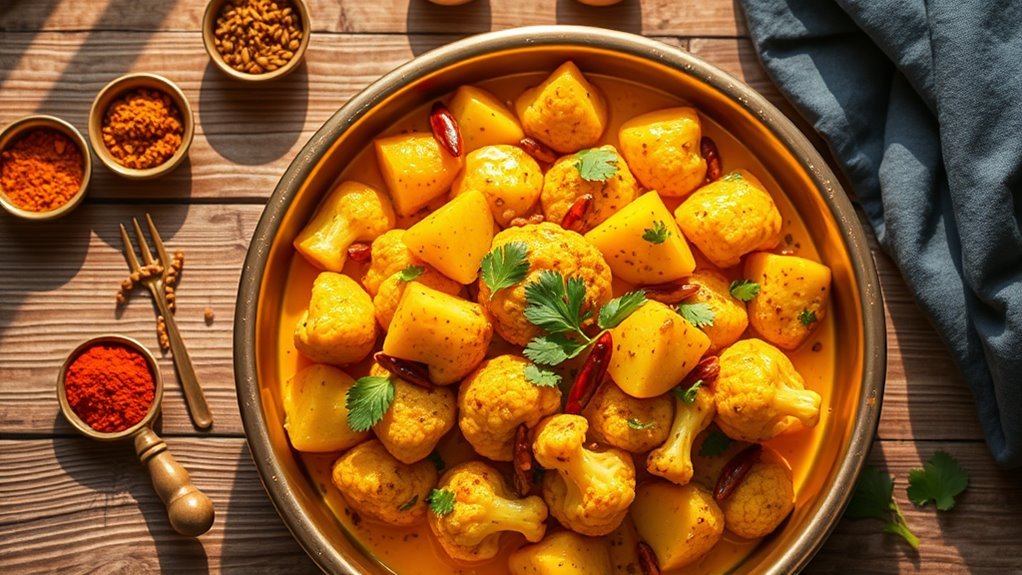
Aloo Gobi is a classic Indian vegetarian dish combining potatoes (aloo) and cauliflower (gobi) in a fragrant blend of spices. This hearty curry showcases the perfect balance between tender potatoes and slightly crisp cauliflower florets, all brought together with aromatic Indian spices and herbs. The versatile dish can be prepared as either a curried or dry version.
The key to perfecting this dish lies in the preparation and cooking sequence. Starting with properly cleaned and sized vegetables, followed by layered spicing techniques, and careful attention to cooking times guarantees each component maintains its ideal texture while absorbing maximum flavor.
| Ingredient | Quantity |
|---|---|
| Cauliflower | 1 medium head, cut into florets |
| Potatoes | 3 medium, cubed |
| Onion | 1 large, finely chopped |
| Tomatoes | 2 medium, chopped |
| Ginger-garlic paste | 2 tablespoons |
| Cumin seeds | 1 teaspoon |
| Turmeric powder | 1 teaspoon |
| Red chili powder | 1 teaspoon |
| Garam masala | 1 teaspoon |
| Coriander powder | 2 teaspoons |
| Cooking oil | 3 tablespoons |
| Salt | to taste |
| Fresh coriander | for garnish |
Heat oil in a large pan over medium heat, add cumin seeds and let them sizzle. Add chopped onions and sauté until golden brown. Mix in ginger-garlic paste and cook until fragrant. Add tomatoes and all dry spices, cooking until oil separates. Add parboiled potatoes and cauliflower florets, stirring to coat with spices. Cover and cook on low heat for 15-20 minutes, stirring occasionally, until vegetables are tender but not mushy. Garnish with fresh coriander before serving.
For best results, parboil potatoes separately until half-done before adding to the curry. Maintain a dry consistency by avoiding excess water addition during cooking. Check vegetable doneness frequently to prevent overcooking, as cauliflower can quickly become mushy. If using a tomato-based gravy, add cashew paste for richness and body. Remember to adjust spice levels according to preference, and allow the dish to rest for 5 minutes before serving to let flavors meld together.
Cooking Tips
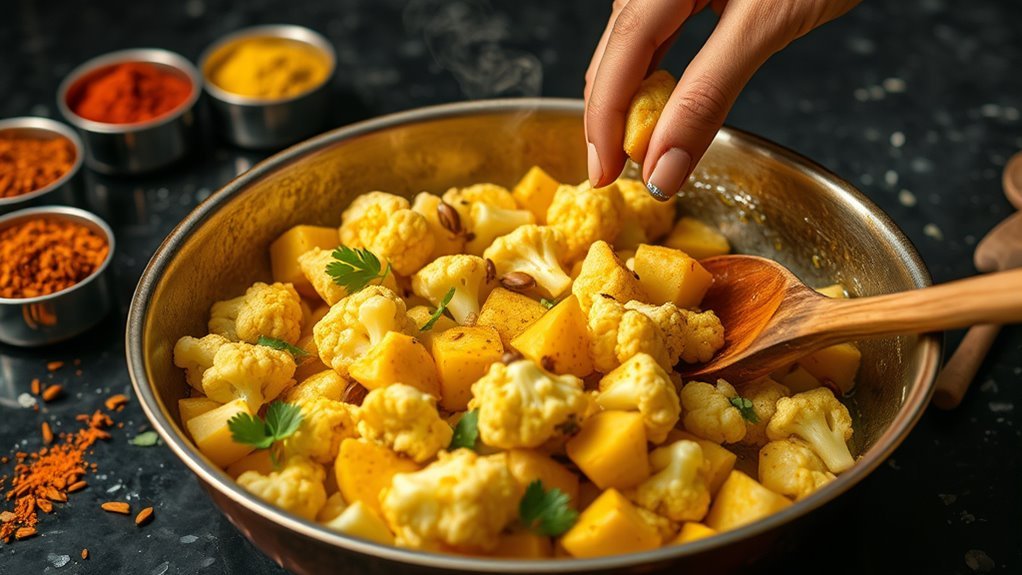
To create the perfect curry, mastering a few essential cooking tips will elevate your dish from good to exceptional.
We’ll want to soak our potatoes first – this reduces starchiness and speeds up cooking.
Let’s layer our flavors by sautéing spices in sequence: cumin seeds first, followed by aromatic ginger, garlic, and onions.
For the best texture, we’ll cut our potatoes uniformly and keep cauliflower florets slightly larger.
Don’t forget to add kasuri methi near the end for that restaurant-style depth, and remember to adjust heat levels – high for sautéing, low for simmering.
Place vegetables in a colander after frying to allow any excess oil to drain properly.
History
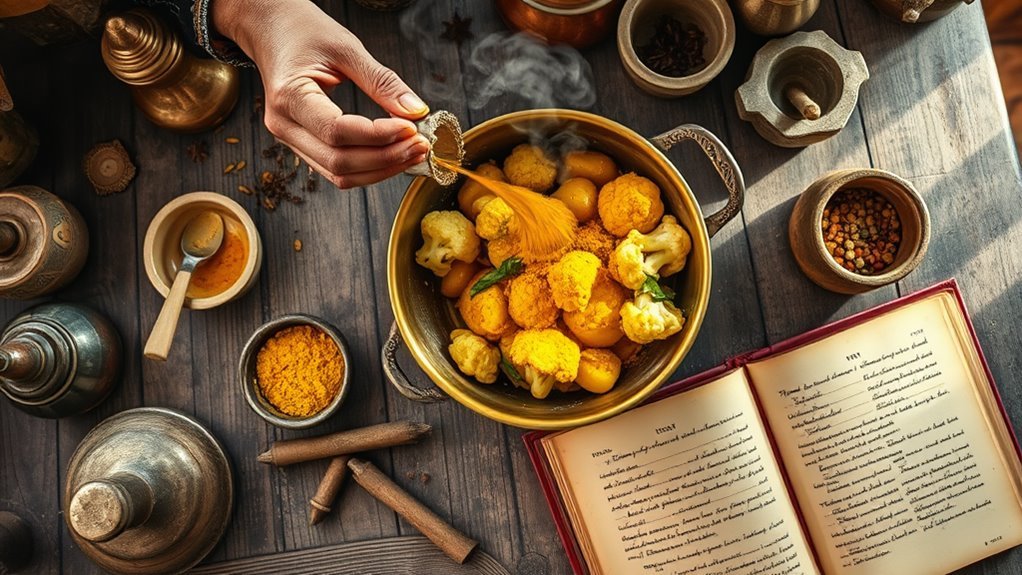
While many beloved Indian dishes trace their roots back centuries, the story of aloo gobi curry began relatively recently with the arrival of its star ingredients. We’ve seen how Portuguese traders brought potatoes to India in the 17th century, followed by cauliflower’s introduction through British colonial efforts in the 1820s. In true Indian spirit, home cooks transformed these foreign vegetables into a beloved dish that’s now central to our cuisine. The creation of aloo gobi represents the birth of culinary innovation as Indian cooks expertly blended new agricultural products into their traditional cooking methods.
| Period | Event | Impact |
|---|---|---|
| 1600s | Portuguese introduce potatoes | New staple crop |
| 1822 | British bring cauliflower | Vegetable diversity |
| 1900s | Regional adaptations emerge | Cultural fusion |
These humble beginnings led to countless regional variations, from Punjab’s tomato-rich versions to Bengal’s aromatic five-spice interpretations.
Final Thoughts
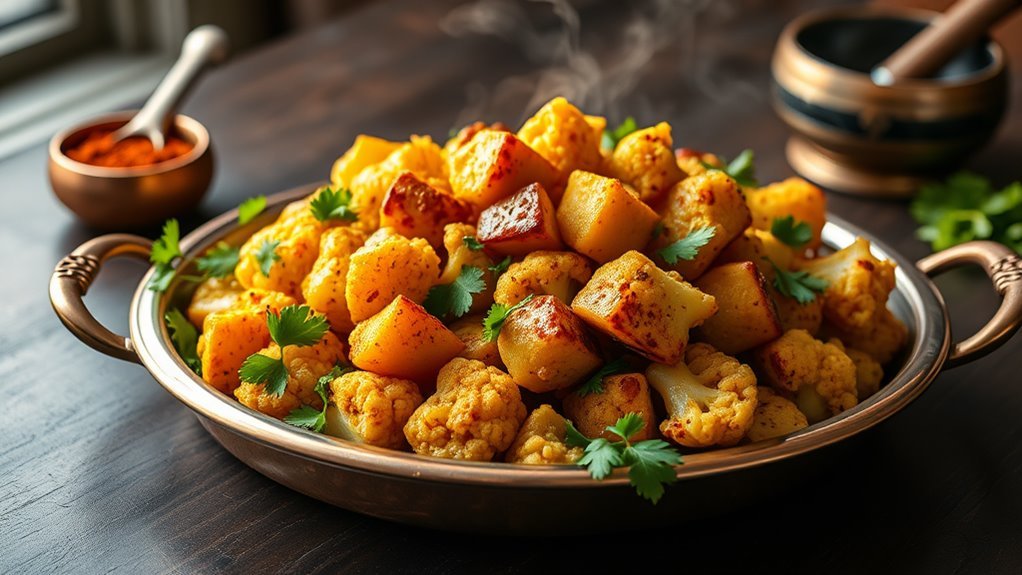
Whether you’re new to Indian cooking or a seasoned chef, this versatile aloo gobi curry has something special to offer everyone.
Although it contains 208 calories per serving, mindful portion control is essential for maintaining a balanced diet.
We love how it adapts to different dietary needs while packing essential nutrients into every bite. From its heart-healthy profile to its diabetes-friendly qualities, this dish proves that healthy eating doesn’t mean sacrificing flavor.
With endless preparation options and spice combinations to explore, we’re confident you’ll find your perfect version.
It’s a proof of Indian cuisine’s ability to transform simple vegetables into an extraordinary meal that’s both nourishing and deeply satisfying.

